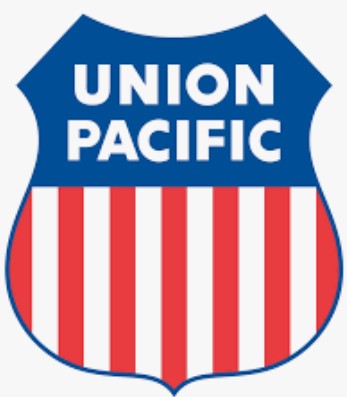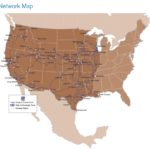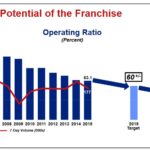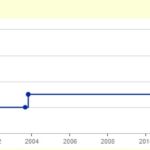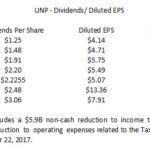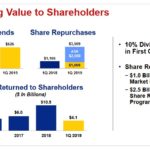Contents
Union Pacific Corporation (UNP) is North America's largest publicly traded Class 1 railroad.
Barriers to entry in this industry are extremely high.
The G55+0 initiative and Unified Plan 2020 have been implemented view the objective of being able to achieve a targeted 55% Operating Ratio within the next few years.
I currently view UNP as slightly overvalued and have it on my 'Watch List'.
Summary
- UNP appeals to me in that it has the largest North American rail network of all publicly traded Class 1 railroads. BNSF also has a sizable rail network but it is owned by Berkshire Hathaway.
- I envision UNP’s G55+0 initiative and Unified Plan 2020 enabling UNP to achieve its targeted 55% Operating Ratio within the next few years.
- Despite extremely challenging weather conditions in Q1 UNP increased earnings 15% from the same period in 2018.
- I do not envision trade negotiations between the US and China being resolved any time soon and fully expect a broad market pullback with UNP’s share price getting caught in any downdraft.
- The US has recently announced its intent to impose tariffs on goods imported from Mexico; cross-border traffic with Mexico comprised ~11% of UNP’s total 2018 volume.
Introduction
This is the third article in a series of articles where I review companies in which I do not currently have exposure but which are on my ‘Watch List’. This article addresses Union Pacific Corporation (UNP).
In addition to looking at the financial aspects of a company I take into consideration other factors such as the industry in which the company competes and how it compares to its peer group.
For example, in the highly fragmented convenience store industry you have two dominant players: 7-11 and Alimentation Couche-Tard (ATD.B). This industry is dominated by two sizable participants with 7-11 being the largest industry participant. It is owned by Seven & I Holdings Co. and is listed solely on the Tokyo stock exchange.
The second largest industry participant is ATD.B. Shares are listed on the TSX in Canada; shares of this company are held in the FFJ Portfolio.
The payments processing industry is another highly competitive industry. The dominant industry participants are Visa Inc. (V), Mastercard Incorporated (MA), American Express Company (AXP), and Discover Financial Services (DFS). V and MA are #1 and #2 and shares are held in undisclosed accounts and within the FFJ Portfolio.
The other major industry participant is China UnionPay but this is not a publicly trade entity.
The North American railroad industry is another industry which appeals to me. The industry is broken down into Class 1, 2, and 3 railroads; only Class 1 railroads are of any interest to me.
At one time there were an extensive number of Class 1 railroads but over the years this has dwindled to just a few. In addition to UNP we have:
- Burlington Northern Santa Fe
- Canadian National Railway Company (CNR.TO)
- Canadian Pacific Railway Limited (CP.TO)
- CSX Corporation (CSX)
- Kansas City Southern (KSU)
- Norfolk Southern Corporation (NSC)
Burlington Northern Sante Fe (BNSF) is a Class 1 railroad but it was acquired by Berkshire Hathaway a few years ago.
I currently hold shares in Canadian National Railway (CNR) and am looking to expand my exposure to this industry. This is a highly capital intensive industry and expanding a rail network is not something that can be easily achieved. I suspect Berkshire Hathaway acquired BNSF a few years ago because it knew that the US economy can not do without railroads and the high level of regulation acts as a deterrent to new entrants.
Business Overview
UNP is the largest publicly traded Class 1 railroad with ~10,000 customers, ~8,300 locomotives, and ~32,200 route miles. The Network Map found below and this route guide give you an indication of the magnitude of UNP’s rail network.
In the Fall of 2015 UNP launched its G55+0 initiative. A key goal of this initiative is to lower UNP’s Operating Ratio to 55%.
The Operating Ratio can be used to determine the efficiency of a company's management by comparing operating expenses to net sales. It is calculated by dividing the operating expenses by the net sales.
A consistent operating ratio of 55% is certainly aggressive with the best Class 1 railroads typically generating operating ratios in the upper 50s; this level is difficult to maintain.
On September 17, 2018, UNP announced its Unified Plan 2020. This new operating plan was launched October 1, 2018 and is being rolled out in phases across the entire UNP rail network. The resulting benefits are expected to help UNP achieve its 60% operating ratio goal by 2020 as it strives to achieve a 55% operating ratio.
Phase 1 of UNP’s G55+0 initiative includes the north to south and Mid-America corridor and included ~160 changes to the transportation plan in that territory. This was substantially completed in late 2018.
In November of 2018, UNP began the planning phase of implementation on the Sunset Route and on the two rail corridors between Los Angeles and Chicago.
Planning for phase 3 began in late January 2019 and includes the Pacific Northwest and Northern California.
Full implementation of all phases of the Unified Plan 2020 is expected by mid-2019.
Evaluation of the entire network will be ongoing with further changes to be made as warranted.
UNP is also working through a terminal rationalization process to more fully optimize its train operations and crew resources.
A recent update on UNP’s Unified Plan 2020 can be found in its Q1 2019 Earnings Presentation.
With the recently announced threat of 5% tariffs on Mexican imports commencing June 10, and potentially increasing to 25%, it is highly probable that UNP will be negatively impacted in that cross-border traffic with Mexico comprised ~11% of UNP’s total 2018 volume. In fact, UNP has the industry’s best access to Mexico and is the only railroad that serves all 6 major rail gateways between the U.S. and Mexico.
Investors also need to keep in mind the extent to which UNP is impacted by fuel prices. Fuel prices are sensitive to global and U.S. domestic demand, refining capacity, geopolitical events, weather conditions and other factors. As prices fluctuate, there will be a timing impact on earnings, as UNP’s fuel surcharge programs trail increases or decreases in fuel price by ~2 months.
Lower fuel prices could positively impact the US economy by increasing consumer discretionary spending that potentially could increase demand for various consumer products that UNP transports. On the flip side, lower fuel prices could negatively impact commodities such as coal and domestic drilling-related shipments
Railroads are highly capital intensive which increases barriers to entry. UNP’s 2019 capital plan, for example, is ~$3.2B which is flat compared to 2018. The plan includes expenditures:
- to renew and improve existing infrastructure as well as new capacity investments designed to support future business growth and operational efficiency;
- for locomotive modernization and freight cars.
Economic conditions in many of UNP’s market sectors continue to drive uncertainty with respect to volume levels. While volume is expected to grow in the low single digit range in 2019 compared to 2018, uncertainties in energy markets and prices, consumer purchases, inflation, and both domestic and international economies will have an impact.
Despite several headwinds, UNP anticipates continued margin improvement resulting from continued pricing opportunities, ongoing G55+0 productivity initiatives, and full implementation of its Unified Plan 2020.
Q1 2019 Results
UNP’s April 18, 2019 Q1 2019 Earnings Release can be accessed here and the accompanying Earnings Presentation can be accessed here.
UNP’s Q1 Operating Ratio came in at 63.6% which is a very slight improvement compared to Q1 2018. Investors need to keep in mind, however, that in Q1 UNP encountered severe winter weather and flooding across its network which adversely impacted volumes and added incremental operating costs; UNP encountered heavy snowfall and harsh winter conditions in the Midwest and Pacific Northwest followed by widespread flooding that washed out its east-west main line in Nebraska for 13 days.
Despite harsh weather conditions in Q1, nearly all of UNP’s metrics improved YoY.
UNP continues to focus on asset utilization which led to a 19% improvement in freight car terminal dwell and a 7% improvement in freight car velocity compared relative to Q1 2018. Train speed for Q1, however, decreased 6% to 23.3 miles per hour as network disruptions had a negative impact.
Locomotive productivity improved 6% versus Q1 2018 as a result of a more efficiently used fleet enabled UNP to park units. In addition, terminal dwell and velocity has been improving suggesting UNP’s efforts to become more efficient are bearing fruit.
A number of other initiatives initiated in Q1 should provide an opportunity for UNP to reduce operational complexity while improving service.
Train length has also been increased 7% in recent months and continued improvement in this measure is expected as the year progresses.
Risk
UNP’s long-term debt has ballooned in recent years having grown from $9.636B as at December 31, 2009 to $20.925B as at December 31, 2018 and $23.409B as at the end of Q1 2019.
This increase in UNP’s debt load no doubt was a factor in Moody’s decision to downgrade UNP’s long-term credit rating one notch from A3 to Baa1 in June 2018; UNP’s rating history by Moody’s can be found below.
Given Moody’s recent downgrade of UNP I am hopeful that no further downgrade will be forthcoming in the near future. I am fully aware UNP may/will experience challenges if the trade issues referenced earlier in this article are not resolved in short order. Having said this, I think the enhancements being made under the G55+0 initiative and Unified Plan 2020 should enable UNP to weather the trade issue headwinds.
S&P Global amended UNP’s long-term debt credit rating to A- at the end of May 2018. This rating is the lowest tier within the upper medium grade category.
Free Cash Flow (FCF)
Earnings can be manipulated. FCF, however, is far more difficult to manipulate. As a result, I will shy away from investing in a company which reports positive EPS but minimal/negative FCF.
In the case of UNP I see that in 2014 – YTD 2019 it generated $3.04B, $2.69B, $4.02B, $3.99B, $5.25B, and $1.21B. I would far prefer to see a steadily improving trend but take some solace in that UNP has consistently reported positive FCF over the past few years.
Valuation
UNP’s PE during 2009 – 2018 was ~17, ~16.8, ~16.9, ~15.2, ~18.5, ~22, ~13.5, ~20.8, ~23.7, and ~9.28.
UNP’s 9.28 PE for FY2018 is an anomaly and should not be relied upon when trying to determine a fair value for UNP. The reason the PE was so low is because on December 22, 2017, The Tax Cuts and Jobs Act was enacted. Significant changes were made to federal tax law, including a reduction in the federal income tax rate from 35% to 21% effective January 1, 2018, 100% bonus depreciation for certain capital expenditures, stricter limits on deductions for interest and certain executive compensation, and a one-time transition tax on previously deferred earnings of certain foreign subsidiaries.
As a result of UNP’s initial analysis of the Tax Act and existing implementation guidance, it remeasured the deferred tax assets and liabilities and computed the transition tax liability net of offsetting foreign tax credits. This resulted in a $5.9B reduction in UNP’s income tax expense in Q4 2017. UNP also recorded a $0.212B reduction to its operating expense related to income tax adjustments at equity-method affiliates in Q4 2017.
If we use UNP’s PE levels for 2009 – 2017 and average them we get a PE close to ~18.3.
UNP generated diluted EPS in 2014 – 2018 of $4.14, $4.71, $5.75, $5.49, $5.07, $13.36, and $7.91; I am unable to locate any specific EPS guidance from management for FY2019.
In a May 29, 2019 Thomson Reuters report I see that UNP’s 5 year trailing PE is 17.3 and the 5 year forward PE is 17.5.
Using another source of information when I last looked at UNP on January 26, 2018 I noticed that 2019 low and high forward adjusted diluted EPS guidance from 25 analysts was $7.01 and $8.90 with the mean being $8.32. UNP was trading at ~$130 giving us a forward adjusted diluted PE of ~15.63.
Using that same source of information I now see guidance from 26 analysts ranges widely with the low and high adjusted EPS estimates for FY2019 coming in at $8.82 and $9.40 and the mean being $9.09. With UNP trading at $166.78 we get a forward adjusted diluted PE of ~18.35.
Another source I use reflects UNP’s forward adjusted diluted PE as being 16.12.
If we take UNP’s current $166.78 share price and a 17.5 PE we then arrive at EPS of $9.53. I do not think UNP is going to increase its EPS from $7.91 in FY2018 to $9.53 in FY2019!
In Q1 2019, UNP increased its EPS 15% to $1.93 and this was achieved during a period in which UNP experienced challenging weather conditions. So, let’s say UNP increases FY2018 EPS of $7.91 by 15% to ~$9.10 for FY2019. Using $9.10 and a 17.5 PE gives us a stock price of ~$159.
I don’t know if UNP’s share price will drop that low but during the December 2018 market swoon, UNP’s share price dropped to ~$132; at that time there was no talk of tariffs being levied against goods imported from Mexico!
If the US carries through with its threat to levy tariffs on goods imported from Mexico it is entirely possible that $9.10 in FY2019 EPS might be a stretch given that cross-border traffic with Mexico comprised ~11% of UNP’s total 2018 volume.
It certainly would not surprise me if UNP’s share price were to experience a pullback to ~$150. If this were to happen and UNP’s earnings were to take a hit and come in at $8.60/share as a result of an unfavorable outcome to trade negotiations then we would have a ~17.44 PE which is pretty close to the 5 year forward PE is 17.5 found in the recent Thomson Reuters report.
While UNP has paid a common stock dividend for 120 consecutive years its dividend history has been somewhat choppy. Investors adamant in receiving a rising dividend from their holdings should not expect UNP to increase its dividend in any consistent pattern.
On May 16, 2019, UNP announced a $0.88 quarterly dividend. I envision UNP will retain its quarterly at the current level until such time as the trade issues with China and Mexico are resolved.
Based on the current $166.78 share price investors are now receiving a ~2.1% dividend yield. This dividend yield might not appeal to some investors given that growth in the share price is likely to be muted until such time as the US’s trade disputes are resolved.
In addition, non US residents who hold UNP shares in taxable accounts incur a withholding tax on dividend income; the withholding tax in Canada is 15% so the $0.88/share quarterly dividend is reduced to $0.748/share which reduces the dividend yield to ~1.8%.
UNP generates ample FCF and Earnings to support its dividend and we see from the following chart a reasonably conservative dividend payout ratio; 2017 results are distorted because of the impact of the Tax Cut and Jobs Act adjustments. I, therefore, recommend you disregard the 2017 dividend payout ratio.
In addition to using earnings generated through normal business operations, UNP has borrowed extensively to reduce the average number of outstanding shares. In FY2018 the weighted-average number of diluted shares outstanding shares amounted to 754.3 million and in Q1 2019 this figure was reduced to 719.5 million. This is a significant reduction from 952.9 million in FY2012!
In Q1 UNP repurchase $1B of its outstanding shares on the open market and under the Accelerated Share Repurchase Program it repurchased another $2.5B of outstanding shares.
Final Thoughts
Despite short-term headwinds, UNP appeals to me as a long-term investment as it is North America’s largest Class 1 railroad. I like that the barriers to entry are extremely high and there are few players in this space.
In my opinion, the G55 +0 and Unified Plan 2020 initiatives will result in an improved Operating Ratio over the next few years; lowering the Operating Ratio from the low 60s to ~55 should significantly improve UNP’s bottom line.
I do, however, have some concerns.
- UNP’s long-term debt has increased significantly in recent years when has resulted in a ratings downgrade in mid 2018.
- UNP’s dramatic reduction in share count in the last few years has had a favorable impact on EPS and the share price. I don’t know to what extent UNP can continue to borrow to reduce share count without risking a further downgrade from the credit rating agencies.
- I do not envision resolution to the US/China trade issues will come about in short order. If these negotiations become prolonged I envision a weakening of the US economy which would negatively impact UNP.
- The recent announcement of tariffs being introduced on products imported from Mexico will likely negatively impact traffic flow between Mexico and the US; UNP relies heavily on Mexico/US cross-border traffic.
I do not envision an early resolution to ongoing trade negotiations and am of the opinion that equity values, in general, are somewhat elevated. I think we will see a broad market pullback within the next few months and UNP’s share price would likely get caught in any downdraft.
It may seem like a stretch but I am prepared to wait for UNP to retrace to the ~$150 level; it did drop to the low $130s in mid-December 2018 so a drop to $150, in my opinion, is not unrealistic.
I hope you found this article helpful and wish you much success on your journey to financial freedom.
Thanks for reading!
Note: I sincerely appreciate the time you took to read this article. Please send any feedback, corrections, or questions to [email protected].
Disclaimer: I have no knowledge of your individual circumstances and am not providing individualized advice or recommendations. I encourage you not to make any investment decision without conducting your own research and due diligence. You should also consult your financial advisor about your specific situation.
Disclosure: I do not hold a position in UNP and do not intend to initiate a position within the next 72 hours.
I wrote this article myself and it expresses my own opinions. I am not receiving compensation for it and have no business relationship with any company whose stock is mentioned in this article.


